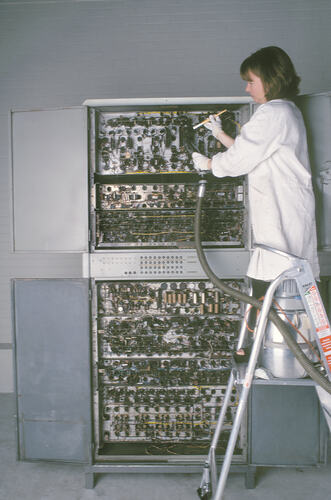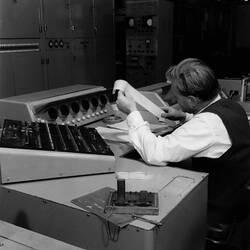The conservation policy for CSIRAC is ultimately the responsibility of Museum Victoria.
However, over the last ten years staff at MV and members of the CSIRAC History Team have collaborated closely and have conferred on conservation issues. This is my understanding of the policies adopted.
Completeness
As a consequence of foresight of the people who passed the machine to the Museum in 1964, and diligent searching for associated artefacts and documents and the gathering of oral histories over the last ten years, the CSIRAC collection consists not only of the computer hardware, but also includes significant software, circuit diagrams, images, related documents and oral histories.
This archive of material means that not only is CSIRAC the only intact first generation machine but it is also remarkably well documented. This archive provides a rich source for scholars of the foundation of the computing age, from both a technical and human viewpoint.
From the beginning, the CSIRAC History Team believed that the most appropriate place for the archival material was at Museum Victoria, so that a single organisation had custody of all the material. Consequently, agreements have been executed for the University of Melbourne to transfer the materials to MV.
A frequent enquiry is whether it is intended to make CSIRAC work again, but no attempt has been made to make the computer operational. It was always seen as impracticable for a number of reasons. During its working life the computer required the constant attention of dedicated engineers to remain operational. The engineers with those skills are no longer available. To restore the computer to operation would require extensive replacement of components - this would prejudice the originality of the machine. Furthermore due to the difficulties in maintaining it the computer would, inevitably, revert to a non-operational (and now non original ) machine.
The memory of CSIRAC used liquid mercury. For occupational and public safety reasons, refilling the memory tubes would be impracticable. What stage of CSIRAC's life should the exhibit represent? The computer had a fifteen year life. It evolved and was modified over that period. However, the overall logic design and primary physical structure did not change substantially, except for the construction of the operator's console as part of the transition from Sydney to Melbourne. Although technical improvements to the computer's timing and addition of peripherals such as 5-channel paper tape equipment were undertaken in Melbourne, the overall, visible aspects of the computer itself were not changed.
The conservation decision was whether the exhibit should reflect the early development in Sydney, the re-commissioning in Melbourne in 1956 or the status and condition of the machine at the end of its working life in 1964. The decision was to adopt the status of the machine at June 1956 when it was re-opened in Melbourne.
I understand the reasons for this were: 'There is photographic and other evidence of the status and condition of the computer at that date.' The paintwork of the computer (particularly the operator's console) was new at that date. The console, in particular was scratched and worn by 1964 and the bare metal deteriorated further in storage in the following decades. Since restoration of the paint was necessary it was appropriate to restore the console to the condition of the opening date in 1956'.
The date 14 June 1956 is an iconic date as it marks the birth of computing in Victoria.
It could be argued that the inclusion of the 5-channel tape equipment, which was installed in the late 1950s in Melbourne, and the inclusion of the program subroutine library which was developed in Melbourne is a departure from the policy. However these are peripheral to the machine itself. The outcome is that the Computer - the centrepiece - is presented as it appeared on the iconic date and it is surrounded with items and equipment which give a realistic and picture of the way it was used on a daily basis between 1956 and 1964.
Peter Thorne 8 November 2006
More Information
-
Keywords
-
Authors
-
Article types


